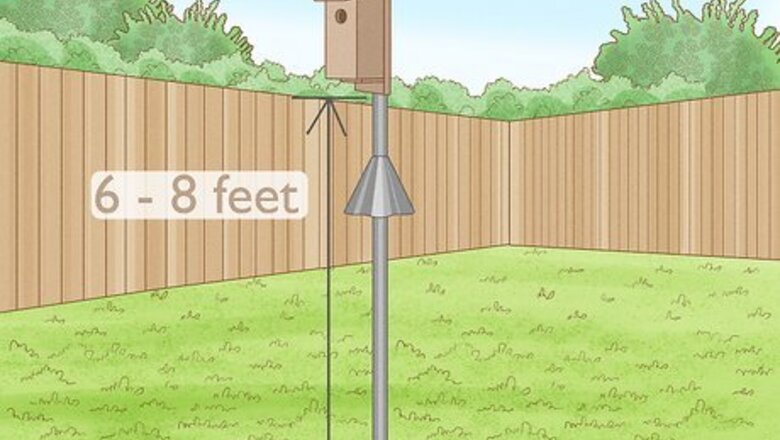
views
- Place a feeder, birdbath, and bluebird nesting box in your yard to attract bluebirds.
- Entice bluebirds by setting out mealworms, berries, and suet.
- Provide nesting materials such as pine needles, bark, and dry grass.
Set up a bluebird nest box.
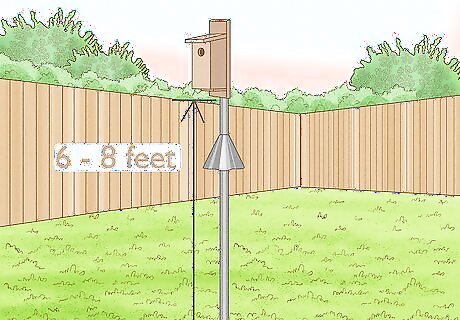
A nest box designed specifically for bluebirds will be more effective than a typical birdhouse. Bluebird houses usually have four walls, a slanted roof, and a hole near the top that’s about 1.5 inches (3.8 cm) wide. Mount the nest at least 6 to 8 feet (1.8 to 2.4 m) high in an open area so that you can monitor it easily.Place a baffle—a sleek, metal cone—on the pole where you’re mounting the birdhouse to keep predators away. Keep bird boxes away from trees or bushes so that squirrels and other predators can’t easily get into them. Avoid placing a birdhouse that’s been made with wood treated with pesticides since this can be harmful to the bluebirds. If you’re placing multiple birdhouses, keep them at least 50 to 100 yards (45 to 91 m) away from each other. Bluebirds are very territorial and will fight over nesting spots.
Buy a bird feeder.
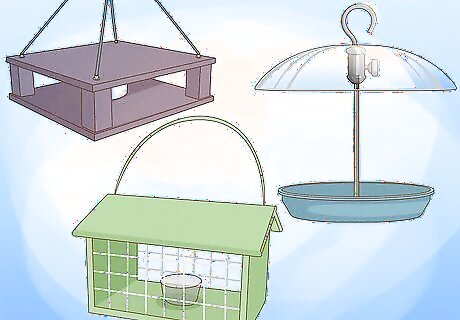
Bluebirds enjoy munching on seeds and fruits from ground feeders. Bluebirds are unique in that they likely won’t eat from standard seed feeders that you hang up. Instead, they prefer ground feeders, platform feeders, or feeders you place in your window. Some of the best feeders for bluebirds include the Gilbertson feeder, the jail feeder, and the dome feeder. Fill your feeder with tasty treats like sunflower hearts, blueberries, softened raisins, and currents. Make sure to clean out the feeder often so that mold and fungi don’t start growing on the inside.
Place a birdbath in your yard.
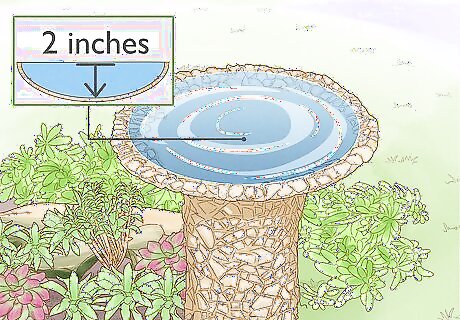
Along with food, bluebirds also need fresh drinking and bathing water. Your guests will be very appreciative if you leave them some fresh, clean water to drink and bathe in. Place your birdbath in a shady spot to keep the water cool and fresh, and fill it so that it’s only about 2 inches (5 cm) deep at its deepest point. Change out the water every day or every other day to keep your birdbath clean In the winter, set out a plastic bowl filled with about 1 inch (2.5 cm) of water and leave it out until ice starts to form.
Entice them with mealworms.
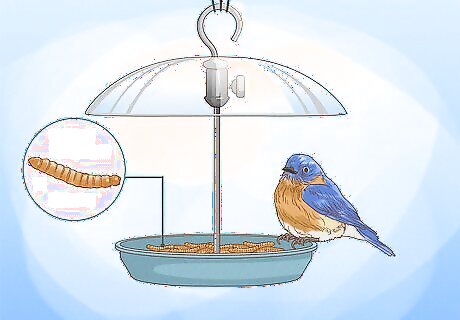
Bluebirds love to snack on mealworms and other insects. Purchase mealworms at your local bait shop, pet store, or bird supply store. Live mealworms are the best for attracting bluebirds, but dried mealworms are also an option. Place them in a shallow dish made of glass, plastic, metal, or any other material that isn’t rough so that the worms can’t escape. Another option is to buy a mealworm feeder that has a hole small enough to keep out larger birds. Bring the mealworms out at the same time each day to train the bluebirds to come to the same place. Early mornings are a good time to feed them. Place live mealworms in your refrigerator to keep them dormant and prevent them from turning into adult beetles. Bluebirds also eat all types of flying insects, grasshoppers, spiders, crickets, and caterpillars.
Make some delicious peanut butter suet.
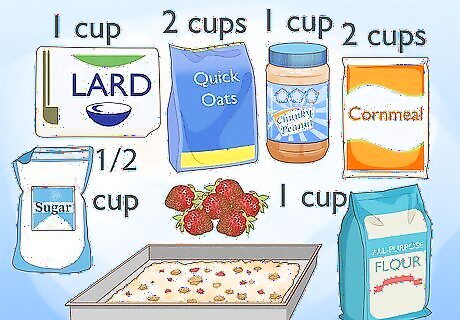
Bluebirds will enjoy a tasty mix of peanut butter, lard, and oats. Melt together 1 cup (240 g) of chunky peanut butter with 1 cup (205 g) of lard. Then, mix in 2 cups (160 g) of quick oats, 2 cups (320 g) of cornmeal, 1 cup (120 g) of flour, ⅓ cup (66 g) of sugar, and a handful of berries. Press the suet into a square pan, let it cool, and freeze it until you’re ready to place it outside. Cut the suet into smaller squares or chunks before leaving it out for the bluebirds. Bluebirds like berries such as raspberries, blackberries, blueberries, and cranberries. Cut the berries into small pieces before mixing them in so that the bluebirds can easily eat them.
Keep your lawn neatly trimmed.
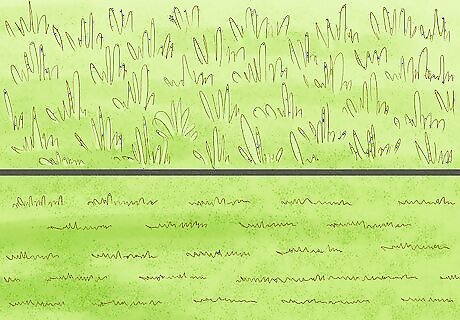
Large, open spaces with short grass are best for bluebirds. You’ll often find bluebirds in big, open spaces, such as golf courses, pastures, parks, and yes, people’s backyards. Bluebirds tend to be in places where the grass is shorter since it allows them to better spot insects and other prey. So make sure to keep your lawn nicely mowed and clean for these feathered guests of honor.
Leave dead trees for bluebirds to use.
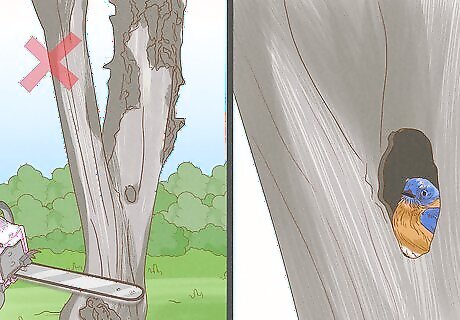
Bluebirds naturally use cavities in dead trees to build their nests. While a dead tree might not be the best for the overall aesthetic of your yard, bluebirds are naturally drawn to them. Bluebirds are “secondary cavity nesters,” meaning that they build their nests in holes previously dug out by other animals, such as woodpeckers or squirrels. A dead tree is basically prime real estate for a bluebird. So if you’ve been procrastinating on getting rid of a fallen or dead tree in your yard, leave it a bit longer to see if any bluebirds come to use it.
Provide bluebirds with nesting materials.
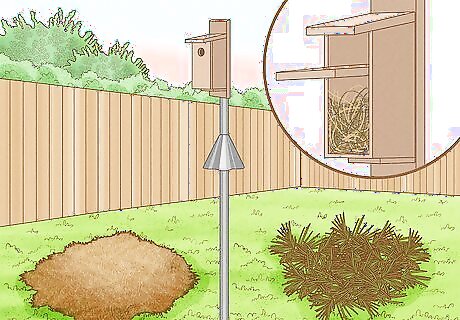
Bluebirds build their nests from things like pine needles and dry grass. When it comes time to make a nest, bluebirds will go scouting for things like dry grasses, pine needles, and strips of bark. If you have any of these materials, place them out in your yard or near your bluebird nesting box to help out your feathered friends. Bluebirds also tend to line their nests with softer materials, so provide them with things like cotton or nesting balls that have soft and cushy materials.
Don’t use pesticides on your grass.
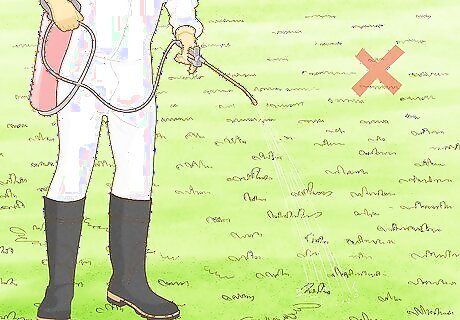
Treating your lawn with pesticides can harm bluebirds. While pesticides are great for getting rid of pesky weeds and insects that are invading your lawn, they can poison bluebirds if accidentally ingested. Bluebirds can also get sick if they happen to eat insects that have ingested some pesticides. Not to mention, bluebirds love to feast on tasty insects, but if you get rid of them, there’ll be no reason for the bluebirds to come to visit you. In short, avoid pesticides at all costs. To avoid using pesticides, plant shrubs and trees that are native to your area. Native plants are well-adapted to deal with local conditions, so you often won’t need to use pesticides or fertilizers to maintain them.
Plant trees and bushes that bear fruit.
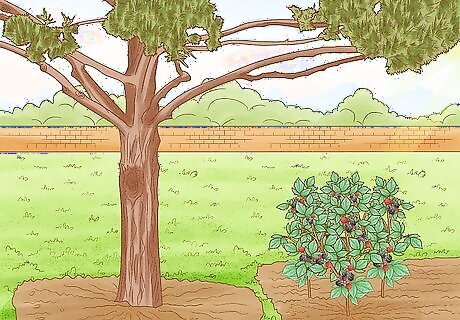
Fruit is a popular meal choice for bluebirds in the winter. If you want to attract bluebirds with some tasty treats when the weather gets cold, plant fruit-bearing shrubs such as dogwood, sumac, serviceberry, viburnum, and blackberry. If you have the space to plant a new tree, go for oak, pine, black cherry, or hackberry. Bluebirds prefer these trees both for the fruits some of them bear and the nesting materials they provide. Keep in mind that bluebirds enjoy open spaces with just a few shrubs and trees here and there. So there’s no need to turn your yard into a forest to get them to come to you.
Provide bluebirds with hunting perches.
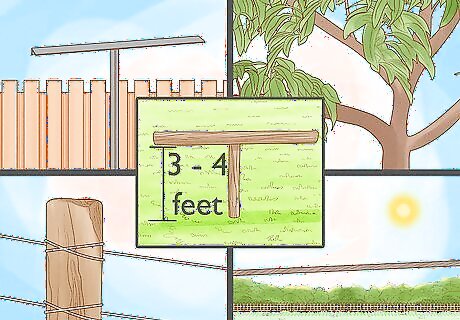
Bluebirds need a spot high up to scan for insects and other prey. Bluebirds perch on things like wires, low-hanging branches, and fenceposts when they’re on the lookout for food. Use old fence posts or create a T-shaped pole to attract bluebirds to your yard. Make your perches so that they’re about 3 to 4 feet (1 to 1.2 m) above the ground.
Keep your cats inside.
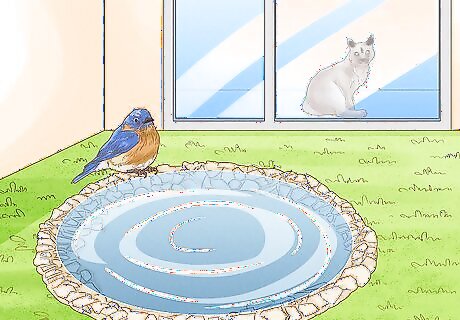
Cats won’t hesitate to chase off any visiting bluebirds. Unfortunately, cats tend to see birds as a rather tasty meal. So if you have any fur babies at home, make sure they stay inside away from the guests of honor. If your cat has to go outside, put a brightly colored collar on them. While this isn’t a 100% effective method, it can help alert birds that they’re being stalked. Taking down your birdfeeder might be the best option for keeping cats away from bluebirds. If there are a lot of birds gathered in one spot, they become much easier for cats to hunt. Place orange or lemon peels around your bluebird house or feeder to help deter cats. Felines normally don’t like the smell of citrus fruits.
Play bluebird calls.
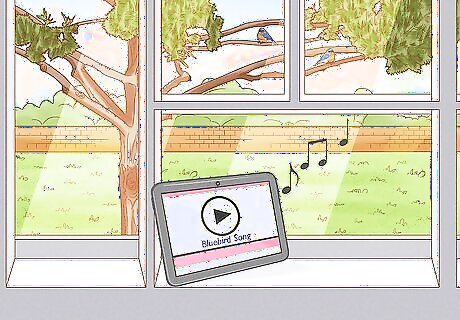
Birds sometimes come when they hear other birds singing. Search up “bluebird song” on the internet and find some recordings to use to draw in nearby bluebirds. Don’t do this too excessively during nesting season (March through August) since this could draw the bluebirds away from guarding their nests, looking after their babies, and hunting for food. If you already have bluebirds coming to your yard, playing these recordings might cause them stress if they think other birds are invading their territory.




















Comments
0 comment